Investigation of Manageable Delays Affecting Construction Projects
VerifiedAdded on 2023/06/10
|95
|18692
|149
Dissertation
AI Summary
This dissertation investigates manageable delays affecting construction projects and analyzes solution methodologies. It begins by introducing the research area, focusing on the UK construction industry and the significant concerns raised by project delays. The study identifies and categorizes delays as manageable or unmanageable, investigating manageable delays through questionnaires distributed to construction practitioners. It develops logical methods for prioritizing delays in the pre-construction phase and explores risk management strategies to minimize their effects. The research incorporates both quantitative and qualitative data analysis, discussing project managers' perspectives and relevant statistics. The dissertation concludes with recommendations for the construction industry, acknowledging research limitations and suggesting future research directions. Desklib provides access to this and other valuable study resources for students.
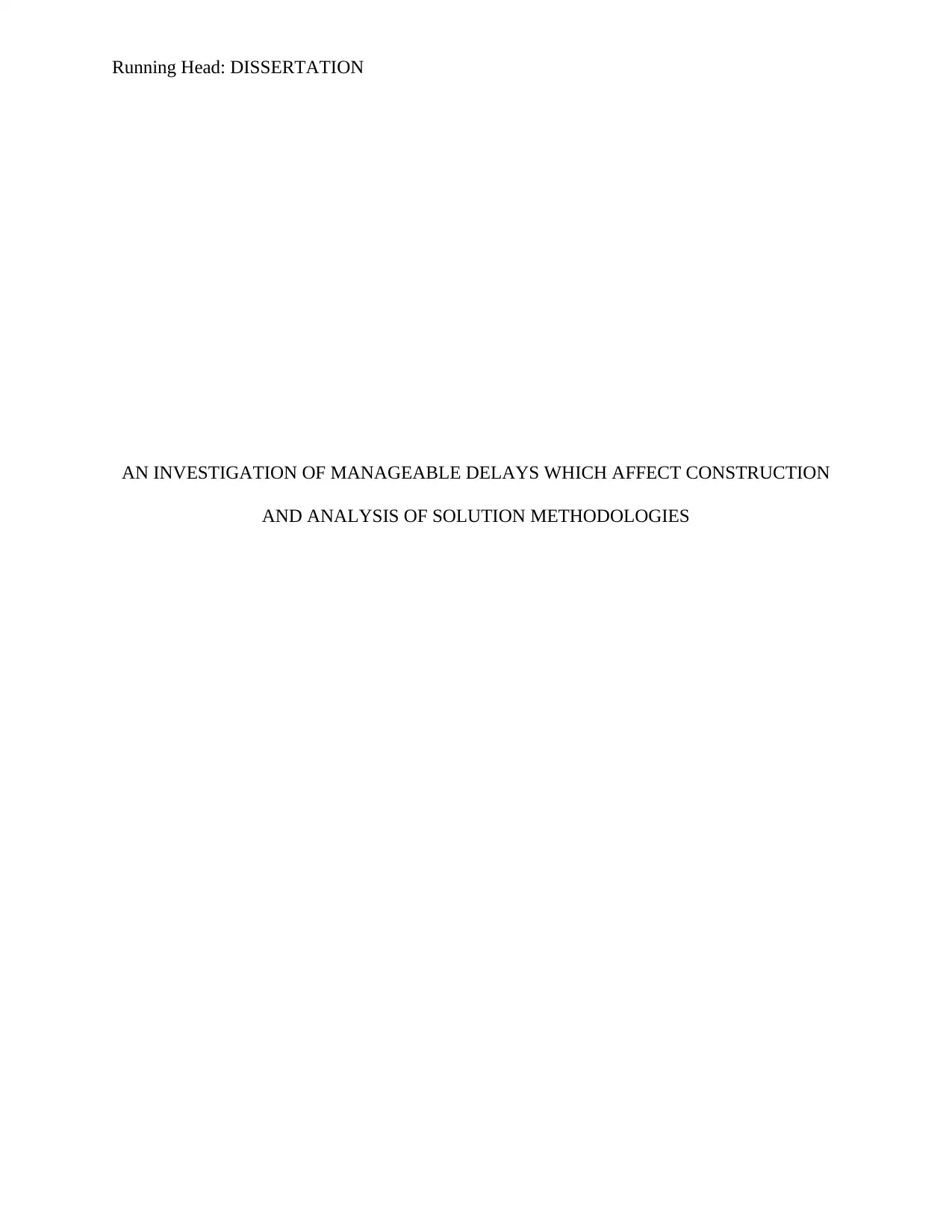
Running Head: DISSERTATION
AN INVESTIGATION OF MANAGEABLE DELAYS WHICH AFFECT CONSTRUCTION
AND ANALYSIS OF SOLUTION METHODOLOGIES
AN INVESTIGATION OF MANAGEABLE DELAYS WHICH AFFECT CONSTRUCTION
AND ANALYSIS OF SOLUTION METHODOLOGIES
Paraphrase This Document
Need a fresh take? Get an instant paraphrase of this document with our AI Paraphraser
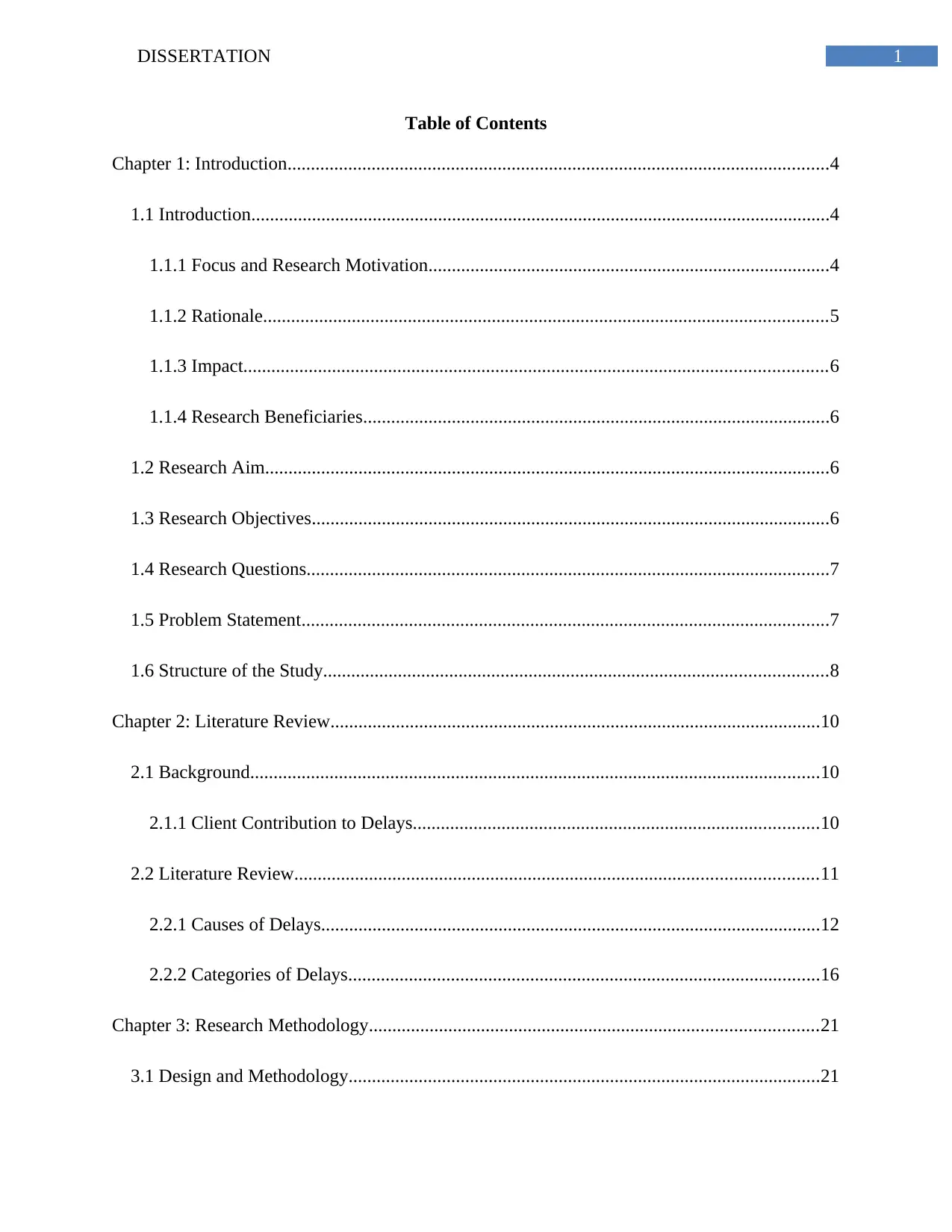
1DISSERTATION
Table of Contents
Chapter 1: Introduction....................................................................................................................4
1.1 Introduction............................................................................................................................4
1.1.1 Focus and Research Motivation......................................................................................4
1.1.2 Rationale.........................................................................................................................5
1.1.3 Impact.............................................................................................................................6
1.1.4 Research Beneficiaries....................................................................................................6
1.2 Research Aim.........................................................................................................................6
1.3 Research Objectives...............................................................................................................6
1.4 Research Questions................................................................................................................7
1.5 Problem Statement.................................................................................................................7
1.6 Structure of the Study............................................................................................................8
Chapter 2: Literature Review.........................................................................................................10
2.1 Background..........................................................................................................................10
2.1.1 Client Contribution to Delays.......................................................................................10
2.2 Literature Review................................................................................................................11
2.2.1 Causes of Delays...........................................................................................................12
2.2.2 Categories of Delays.....................................................................................................16
Chapter 3: Research Methodology................................................................................................21
3.1 Design and Methodology.....................................................................................................21
Table of Contents
Chapter 1: Introduction....................................................................................................................4
1.1 Introduction............................................................................................................................4
1.1.1 Focus and Research Motivation......................................................................................4
1.1.2 Rationale.........................................................................................................................5
1.1.3 Impact.............................................................................................................................6
1.1.4 Research Beneficiaries....................................................................................................6
1.2 Research Aim.........................................................................................................................6
1.3 Research Objectives...............................................................................................................6
1.4 Research Questions................................................................................................................7
1.5 Problem Statement.................................................................................................................7
1.6 Structure of the Study............................................................................................................8
Chapter 2: Literature Review.........................................................................................................10
2.1 Background..........................................................................................................................10
2.1.1 Client Contribution to Delays.......................................................................................10
2.2 Literature Review................................................................................................................11
2.2.1 Causes of Delays...........................................................................................................12
2.2.2 Categories of Delays.....................................................................................................16
Chapter 3: Research Methodology................................................................................................21
3.1 Design and Methodology.....................................................................................................21
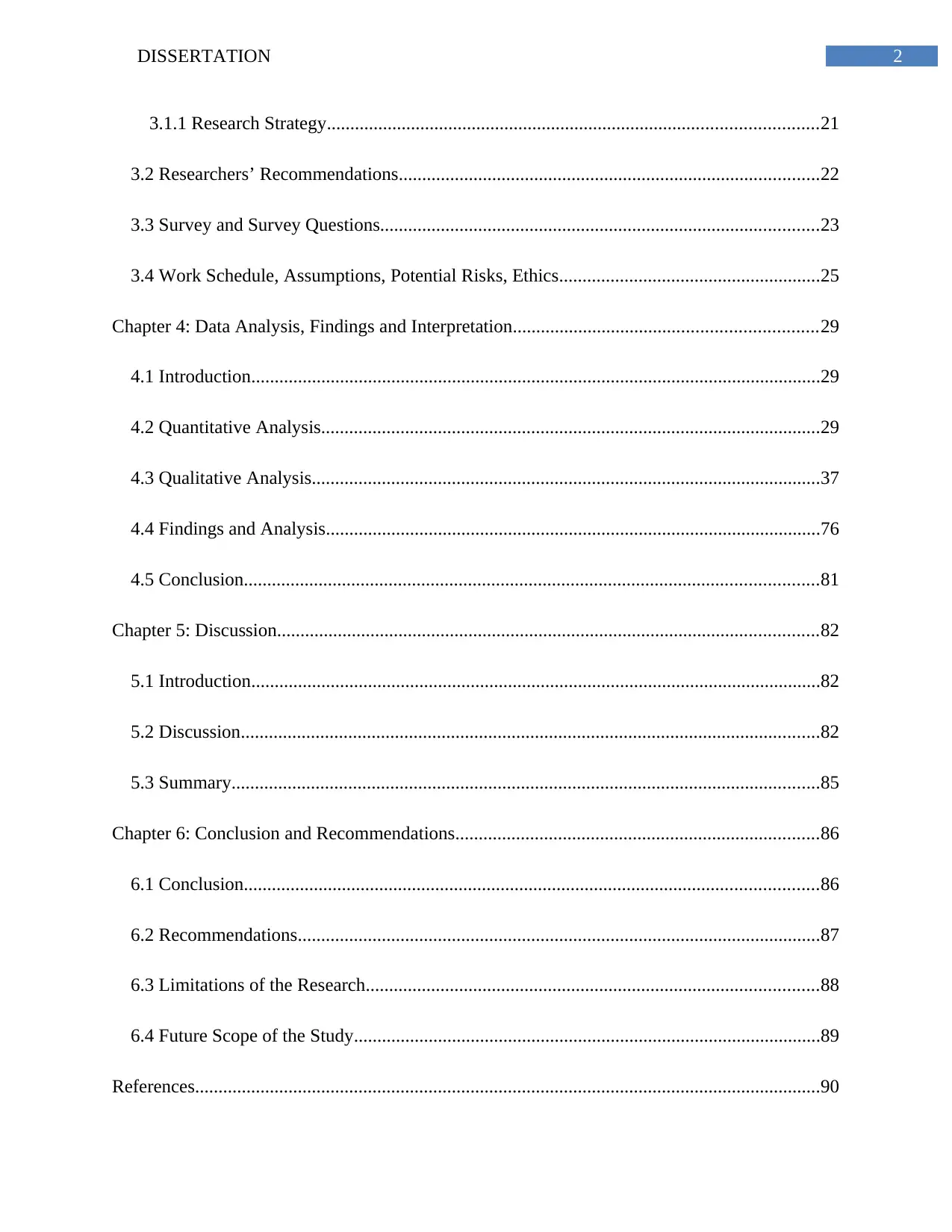
2DISSERTATION
3.1.1 Research Strategy.........................................................................................................21
3.2 Researchers’ Recommendations..........................................................................................22
3.3 Survey and Survey Questions..............................................................................................23
3.4 Work Schedule, Assumptions, Potential Risks, Ethics........................................................25
Chapter 4: Data Analysis, Findings and Interpretation.................................................................29
4.1 Introduction..........................................................................................................................29
4.2 Quantitative Analysis...........................................................................................................29
4.3 Qualitative Analysis.............................................................................................................37
4.4 Findings and Analysis..........................................................................................................76
4.5 Conclusion...........................................................................................................................81
Chapter 5: Discussion....................................................................................................................82
5.1 Introduction..........................................................................................................................82
5.2 Discussion............................................................................................................................82
5.3 Summary..............................................................................................................................85
Chapter 6: Conclusion and Recommendations..............................................................................86
6.1 Conclusion...........................................................................................................................86
6.2 Recommendations................................................................................................................87
6.3 Limitations of the Research.................................................................................................88
6.4 Future Scope of the Study....................................................................................................89
References......................................................................................................................................90
3.1.1 Research Strategy.........................................................................................................21
3.2 Researchers’ Recommendations..........................................................................................22
3.3 Survey and Survey Questions..............................................................................................23
3.4 Work Schedule, Assumptions, Potential Risks, Ethics........................................................25
Chapter 4: Data Analysis, Findings and Interpretation.................................................................29
4.1 Introduction..........................................................................................................................29
4.2 Quantitative Analysis...........................................................................................................29
4.3 Qualitative Analysis.............................................................................................................37
4.4 Findings and Analysis..........................................................................................................76
4.5 Conclusion...........................................................................................................................81
Chapter 5: Discussion....................................................................................................................82
5.1 Introduction..........................................................................................................................82
5.2 Discussion............................................................................................................................82
5.3 Summary..............................................................................................................................85
Chapter 6: Conclusion and Recommendations..............................................................................86
6.1 Conclusion...........................................................................................................................86
6.2 Recommendations................................................................................................................87
6.3 Limitations of the Research.................................................................................................88
6.4 Future Scope of the Study....................................................................................................89
References......................................................................................................................................90
⊘ This is a preview!⊘
Do you want full access?
Subscribe today to unlock all pages.

Trusted by 1+ million students worldwide

3DISSERTATION
Appendices..................................................................................................................................101
Appendix 1: Gantt Chart..........................................................................................................101
Appendix 2: Survey Results....................................................................................................102
Appendices..................................................................................................................................101
Appendix 1: Gantt Chart..........................................................................................................101
Appendix 2: Survey Results....................................................................................................102
Paraphrase This Document
Need a fresh take? Get an instant paraphrase of this document with our AI Paraphraser

4DISSERTATION
Chapter 1: Introduction
1.1 Introduction
Construction projects involve design and development of generally large structures like
buildings, bridges, pillars, platforms and others. Due to complex nature and vast scale of almost
all of the construction projects, the project managers often face significant amount of delays
throughout the course of the project (Van, Sang & Viet, 2015). As for the construction projects,
it is not possible to completely prevent the delays, so only the primary concerns that are related
with the research can be migrated that are regarded as manageable delays (Sears et al., 2015).
These issues are considered to be within the capability of parties managing the project using risk
management techniques and other techniques used in project management like avoidance, loss
prevention, loss reduction, separation, duplication, diversification and others. Construction
industry plays a very major role for the economic as well as social growth of United Kingdom.
There are various major and minor stakeholders who are involved in the construction industries
including the clients, designers, trade personnel, professional bodies, material suppliers,
specialists, and contractors. The construction project rose to a level higher making a record of
£99,266 million in year 2016. According to the office of National Statistics, this hike has
widened the scope of construction jobs as seen from the statistic that almost 2.96 million people
are directly or indirectly employed in the UK construction industry that roughly contributes to
9% of total of 32.2 million employments in UK (Construction statistic, 2017).
1.1.1 Focus and Research Motivation
According to an estimated made by the national audit office report the construction
projects of UK (Assaf and Al-Hejji, 2006), about 70% of project in UK were not delivered on
Chapter 1: Introduction
1.1 Introduction
Construction projects involve design and development of generally large structures like
buildings, bridges, pillars, platforms and others. Due to complex nature and vast scale of almost
all of the construction projects, the project managers often face significant amount of delays
throughout the course of the project (Van, Sang & Viet, 2015). As for the construction projects,
it is not possible to completely prevent the delays, so only the primary concerns that are related
with the research can be migrated that are regarded as manageable delays (Sears et al., 2015).
These issues are considered to be within the capability of parties managing the project using risk
management techniques and other techniques used in project management like avoidance, loss
prevention, loss reduction, separation, duplication, diversification and others. Construction
industry plays a very major role for the economic as well as social growth of United Kingdom.
There are various major and minor stakeholders who are involved in the construction industries
including the clients, designers, trade personnel, professional bodies, material suppliers,
specialists, and contractors. The construction project rose to a level higher making a record of
£99,266 million in year 2016. According to the office of National Statistics, this hike has
widened the scope of construction jobs as seen from the statistic that almost 2.96 million people
are directly or indirectly employed in the UK construction industry that roughly contributes to
9% of total of 32.2 million employments in UK (Construction statistic, 2017).
1.1.1 Focus and Research Motivation
According to an estimated made by the national audit office report the construction
projects of UK (Assaf and Al-Hejji, 2006), about 70% of project in UK were not delivered on
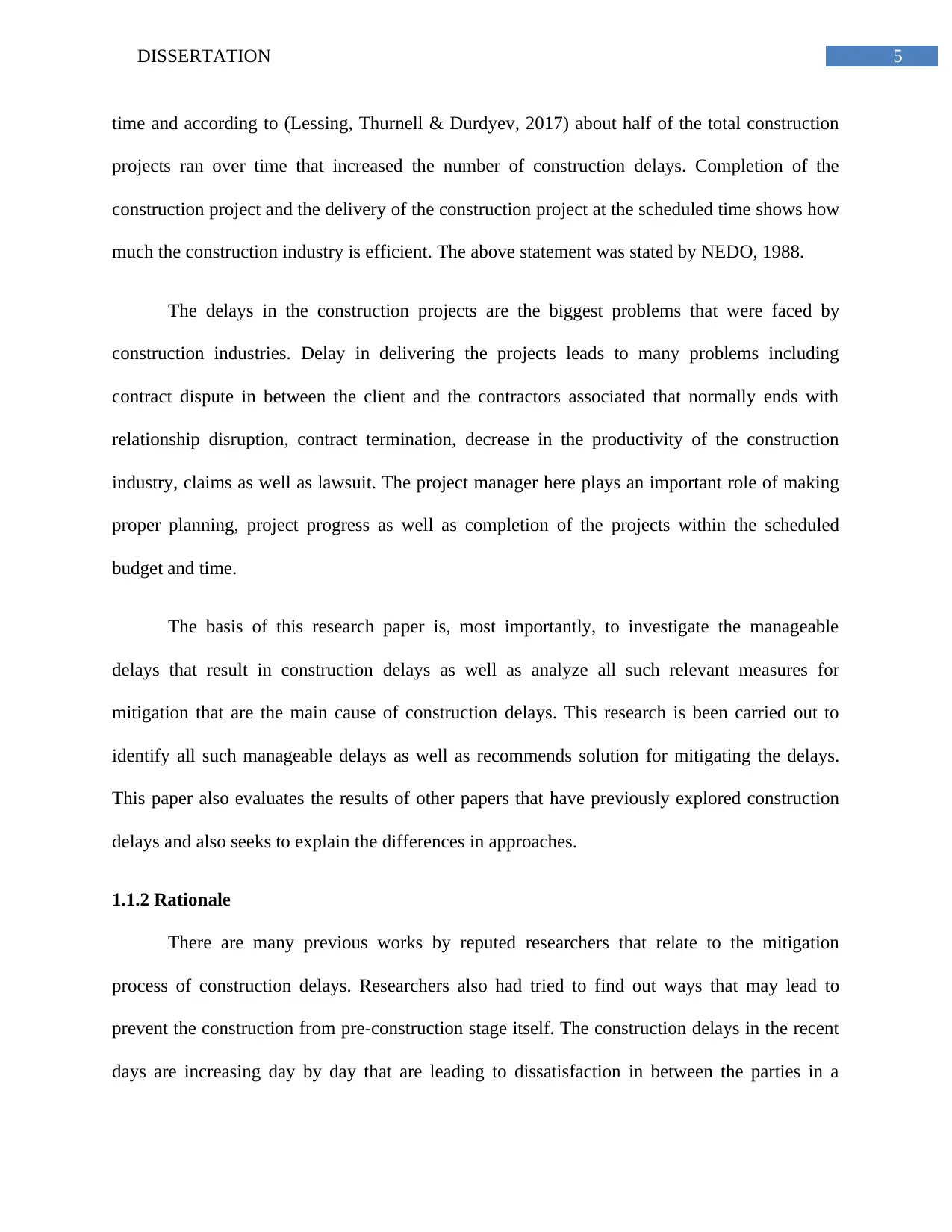
5DISSERTATION
time and according to (Lessing, Thurnell & Durdyev, 2017) about half of the total construction
projects ran over time that increased the number of construction delays. Completion of the
construction project and the delivery of the construction project at the scheduled time shows how
much the construction industry is efficient. The above statement was stated by NEDO, 1988.
The delays in the construction projects are the biggest problems that were faced by
construction industries. Delay in delivering the projects leads to many problems including
contract dispute in between the client and the contractors associated that normally ends with
relationship disruption, contract termination, decrease in the productivity of the construction
industry, claims as well as lawsuit. The project manager here plays an important role of making
proper planning, project progress as well as completion of the projects within the scheduled
budget and time.
The basis of this research paper is, most importantly, to investigate the manageable
delays that result in construction delays as well as analyze all such relevant measures for
mitigation that are the main cause of construction delays. This research is been carried out to
identify all such manageable delays as well as recommends solution for mitigating the delays.
This paper also evaluates the results of other papers that have previously explored construction
delays and also seeks to explain the differences in approaches.
1.1.2 Rationale
There are many previous works by reputed researchers that relate to the mitigation
process of construction delays. Researchers also had tried to find out ways that may lead to
prevent the construction from pre-construction stage itself. The construction delays in the recent
days are increasing day by day that are leading to dissatisfaction in between the parties in a
time and according to (Lessing, Thurnell & Durdyev, 2017) about half of the total construction
projects ran over time that increased the number of construction delays. Completion of the
construction project and the delivery of the construction project at the scheduled time shows how
much the construction industry is efficient. The above statement was stated by NEDO, 1988.
The delays in the construction projects are the biggest problems that were faced by
construction industries. Delay in delivering the projects leads to many problems including
contract dispute in between the client and the contractors associated that normally ends with
relationship disruption, contract termination, decrease in the productivity of the construction
industry, claims as well as lawsuit. The project manager here plays an important role of making
proper planning, project progress as well as completion of the projects within the scheduled
budget and time.
The basis of this research paper is, most importantly, to investigate the manageable
delays that result in construction delays as well as analyze all such relevant measures for
mitigation that are the main cause of construction delays. This research is been carried out to
identify all such manageable delays as well as recommends solution for mitigating the delays.
This paper also evaluates the results of other papers that have previously explored construction
delays and also seeks to explain the differences in approaches.
1.1.2 Rationale
There are many previous works by reputed researchers that relate to the mitigation
process of construction delays. Researchers also had tried to find out ways that may lead to
prevent the construction from pre-construction stage itself. The construction delays in the recent
days are increasing day by day that are leading to dissatisfaction in between the parties in a
⊘ This is a preview!⊘
Do you want full access?
Subscribe today to unlock all pages.

Trusted by 1+ million students worldwide
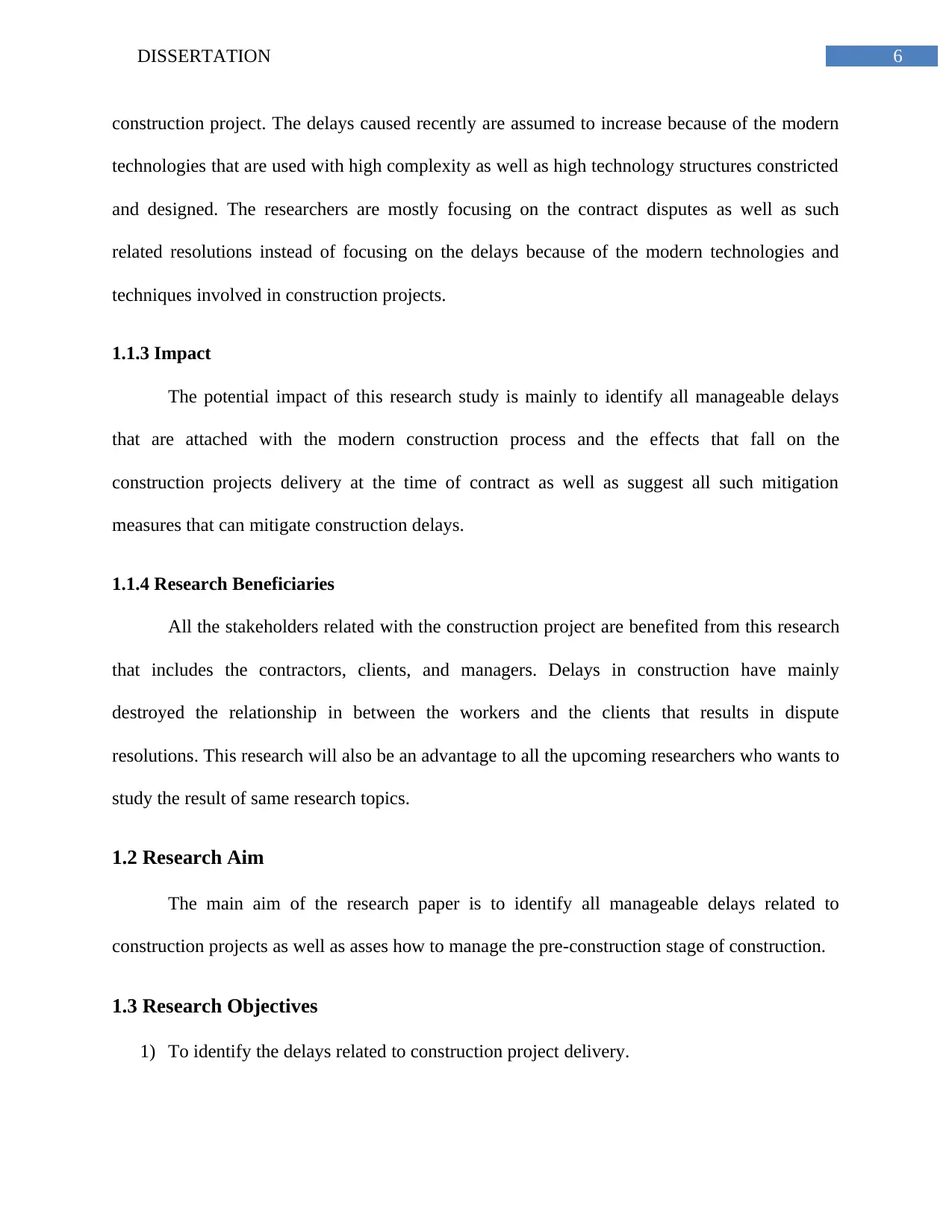
6DISSERTATION
construction project. The delays caused recently are assumed to increase because of the modern
technologies that are used with high complexity as well as high technology structures constricted
and designed. The researchers are mostly focusing on the contract disputes as well as such
related resolutions instead of focusing on the delays because of the modern technologies and
techniques involved in construction projects.
1.1.3 Impact
The potential impact of this research study is mainly to identify all manageable delays
that are attached with the modern construction process and the effects that fall on the
construction projects delivery at the time of contract as well as suggest all such mitigation
measures that can mitigate construction delays.
1.1.4 Research Beneficiaries
All the stakeholders related with the construction project are benefited from this research
that includes the contractors, clients, and managers. Delays in construction have mainly
destroyed the relationship in between the workers and the clients that results in dispute
resolutions. This research will also be an advantage to all the upcoming researchers who wants to
study the result of same research topics.
1.2 Research Aim
The main aim of the research paper is to identify all manageable delays related to
construction projects as well as asses how to manage the pre-construction stage of construction.
1.3 Research Objectives
1) To identify the delays related to construction project delivery.
construction project. The delays caused recently are assumed to increase because of the modern
technologies that are used with high complexity as well as high technology structures constricted
and designed. The researchers are mostly focusing on the contract disputes as well as such
related resolutions instead of focusing on the delays because of the modern technologies and
techniques involved in construction projects.
1.1.3 Impact
The potential impact of this research study is mainly to identify all manageable delays
that are attached with the modern construction process and the effects that fall on the
construction projects delivery at the time of contract as well as suggest all such mitigation
measures that can mitigate construction delays.
1.1.4 Research Beneficiaries
All the stakeholders related with the construction project are benefited from this research
that includes the contractors, clients, and managers. Delays in construction have mainly
destroyed the relationship in between the workers and the clients that results in dispute
resolutions. This research will also be an advantage to all the upcoming researchers who wants to
study the result of same research topics.
1.2 Research Aim
The main aim of the research paper is to identify all manageable delays related to
construction projects as well as asses how to manage the pre-construction stage of construction.
1.3 Research Objectives
1) To identify the delays related to construction project delivery.
Paraphrase This Document
Need a fresh take? Get an instant paraphrase of this document with our AI Paraphraser
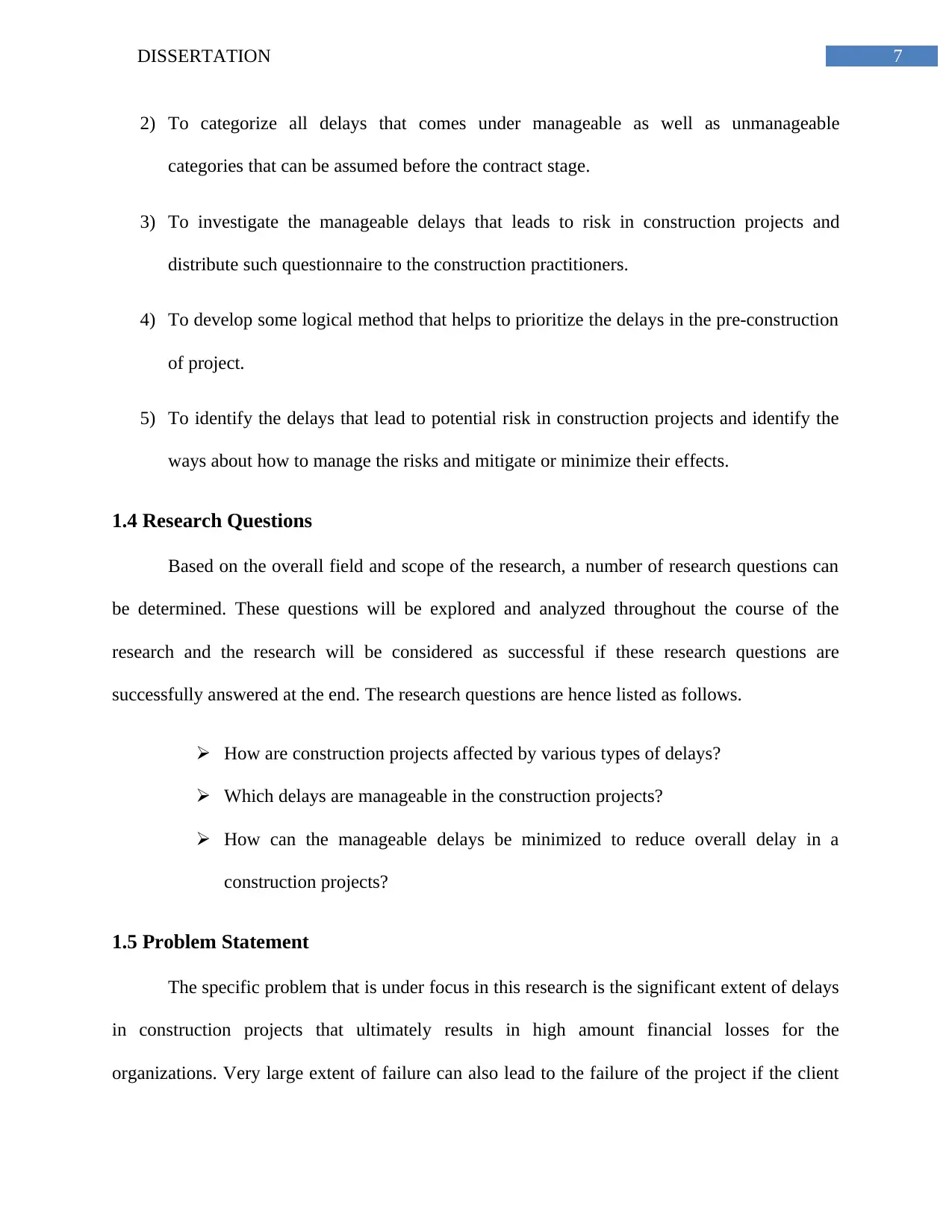
7DISSERTATION
2) To categorize all delays that comes under manageable as well as unmanageable
categories that can be assumed before the contract stage.
3) To investigate the manageable delays that leads to risk in construction projects and
distribute such questionnaire to the construction practitioners.
4) To develop some logical method that helps to prioritize the delays in the pre-construction
of project.
5) To identify the delays that lead to potential risk in construction projects and identify the
ways about how to manage the risks and mitigate or minimize their effects.
1.4 Research Questions
Based on the overall field and scope of the research, a number of research questions can
be determined. These questions will be explored and analyzed throughout the course of the
research and the research will be considered as successful if these research questions are
successfully answered at the end. The research questions are hence listed as follows.
How are construction projects affected by various types of delays?
Which delays are manageable in the construction projects?
How can the manageable delays be minimized to reduce overall delay in a
construction projects?
1.5 Problem Statement
The specific problem that is under focus in this research is the significant extent of delays
in construction projects that ultimately results in high amount financial losses for the
organizations. Very large extent of failure can also lead to the failure of the project if the client
2) To categorize all delays that comes under manageable as well as unmanageable
categories that can be assumed before the contract stage.
3) To investigate the manageable delays that leads to risk in construction projects and
distribute such questionnaire to the construction practitioners.
4) To develop some logical method that helps to prioritize the delays in the pre-construction
of project.
5) To identify the delays that lead to potential risk in construction projects and identify the
ways about how to manage the risks and mitigate or minimize their effects.
1.4 Research Questions
Based on the overall field and scope of the research, a number of research questions can
be determined. These questions will be explored and analyzed throughout the course of the
research and the research will be considered as successful if these research questions are
successfully answered at the end. The research questions are hence listed as follows.
How are construction projects affected by various types of delays?
Which delays are manageable in the construction projects?
How can the manageable delays be minimized to reduce overall delay in a
construction projects?
1.5 Problem Statement
The specific problem that is under focus in this research is the significant extent of delays
in construction projects that ultimately results in high amount financial losses for the
organizations. Very large extent of failure can also lead to the failure of the project if the client
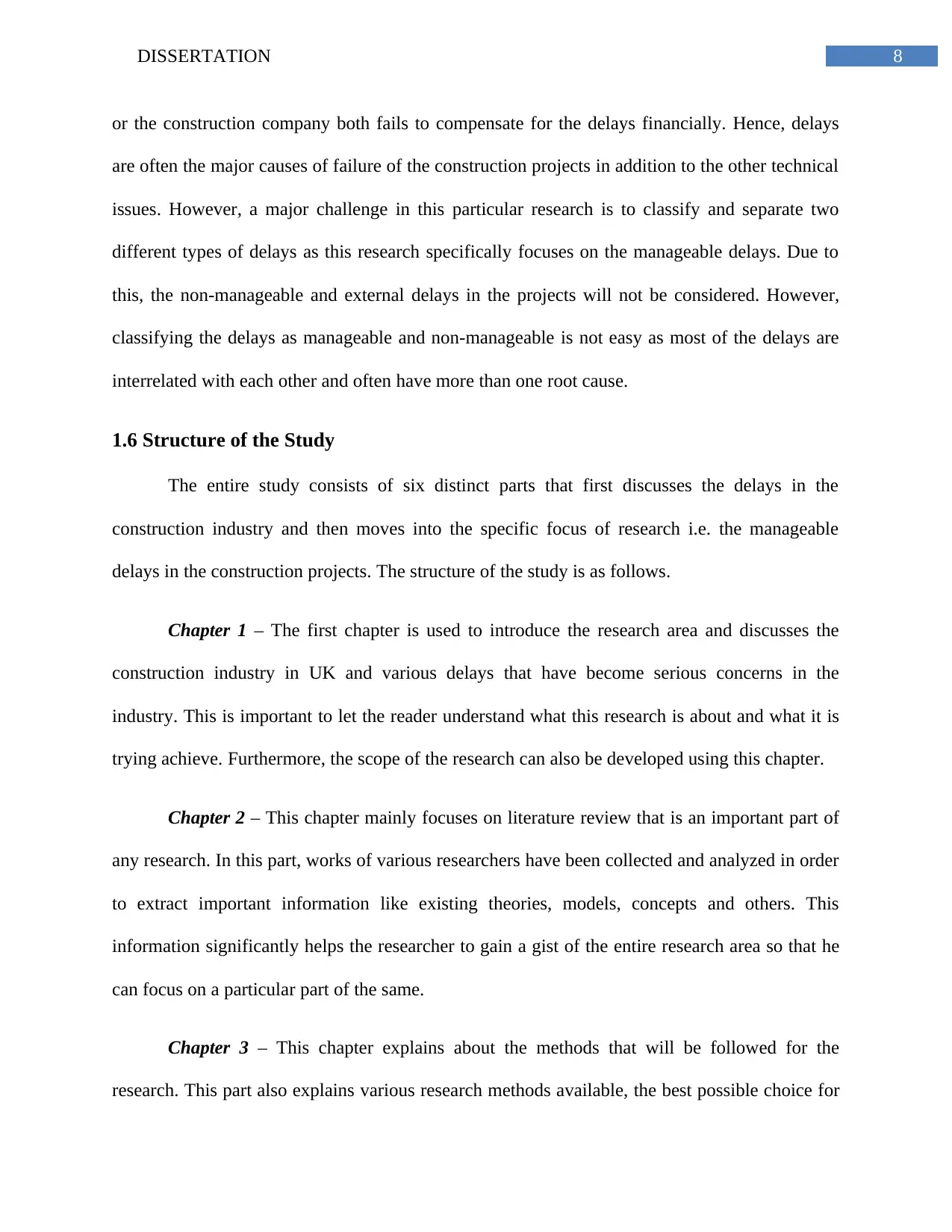
8DISSERTATION
or the construction company both fails to compensate for the delays financially. Hence, delays
are often the major causes of failure of the construction projects in addition to the other technical
issues. However, a major challenge in this particular research is to classify and separate two
different types of delays as this research specifically focuses on the manageable delays. Due to
this, the non-manageable and external delays in the projects will not be considered. However,
classifying the delays as manageable and non-manageable is not easy as most of the delays are
interrelated with each other and often have more than one root cause.
1.6 Structure of the Study
The entire study consists of six distinct parts that first discusses the delays in the
construction industry and then moves into the specific focus of research i.e. the manageable
delays in the construction projects. The structure of the study is as follows.
Chapter 1 – The first chapter is used to introduce the research area and discusses the
construction industry in UK and various delays that have become serious concerns in the
industry. This is important to let the reader understand what this research is about and what it is
trying achieve. Furthermore, the scope of the research can also be developed using this chapter.
Chapter 2 – This chapter mainly focuses on literature review that is an important part of
any research. In this part, works of various researchers have been collected and analyzed in order
to extract important information like existing theories, models, concepts and others. This
information significantly helps the researcher to gain a gist of the entire research area so that he
can focus on a particular part of the same.
Chapter 3 – This chapter explains about the methods that will be followed for the
research. This part also explains various research methods available, the best possible choice for
or the construction company both fails to compensate for the delays financially. Hence, delays
are often the major causes of failure of the construction projects in addition to the other technical
issues. However, a major challenge in this particular research is to classify and separate two
different types of delays as this research specifically focuses on the manageable delays. Due to
this, the non-manageable and external delays in the projects will not be considered. However,
classifying the delays as manageable and non-manageable is not easy as most of the delays are
interrelated with each other and often have more than one root cause.
1.6 Structure of the Study
The entire study consists of six distinct parts that first discusses the delays in the
construction industry and then moves into the specific focus of research i.e. the manageable
delays in the construction projects. The structure of the study is as follows.
Chapter 1 – The first chapter is used to introduce the research area and discusses the
construction industry in UK and various delays that have become serious concerns in the
industry. This is important to let the reader understand what this research is about and what it is
trying achieve. Furthermore, the scope of the research can also be developed using this chapter.
Chapter 2 – This chapter mainly focuses on literature review that is an important part of
any research. In this part, works of various researchers have been collected and analyzed in order
to extract important information like existing theories, models, concepts and others. This
information significantly helps the researcher to gain a gist of the entire research area so that he
can focus on a particular part of the same.
Chapter 3 – This chapter explains about the methods that will be followed for the
research. This part also explains various research methods available, the best possible choice for
⊘ This is a preview!⊘
Do you want full access?
Subscribe today to unlock all pages.

Trusted by 1+ million students worldwide
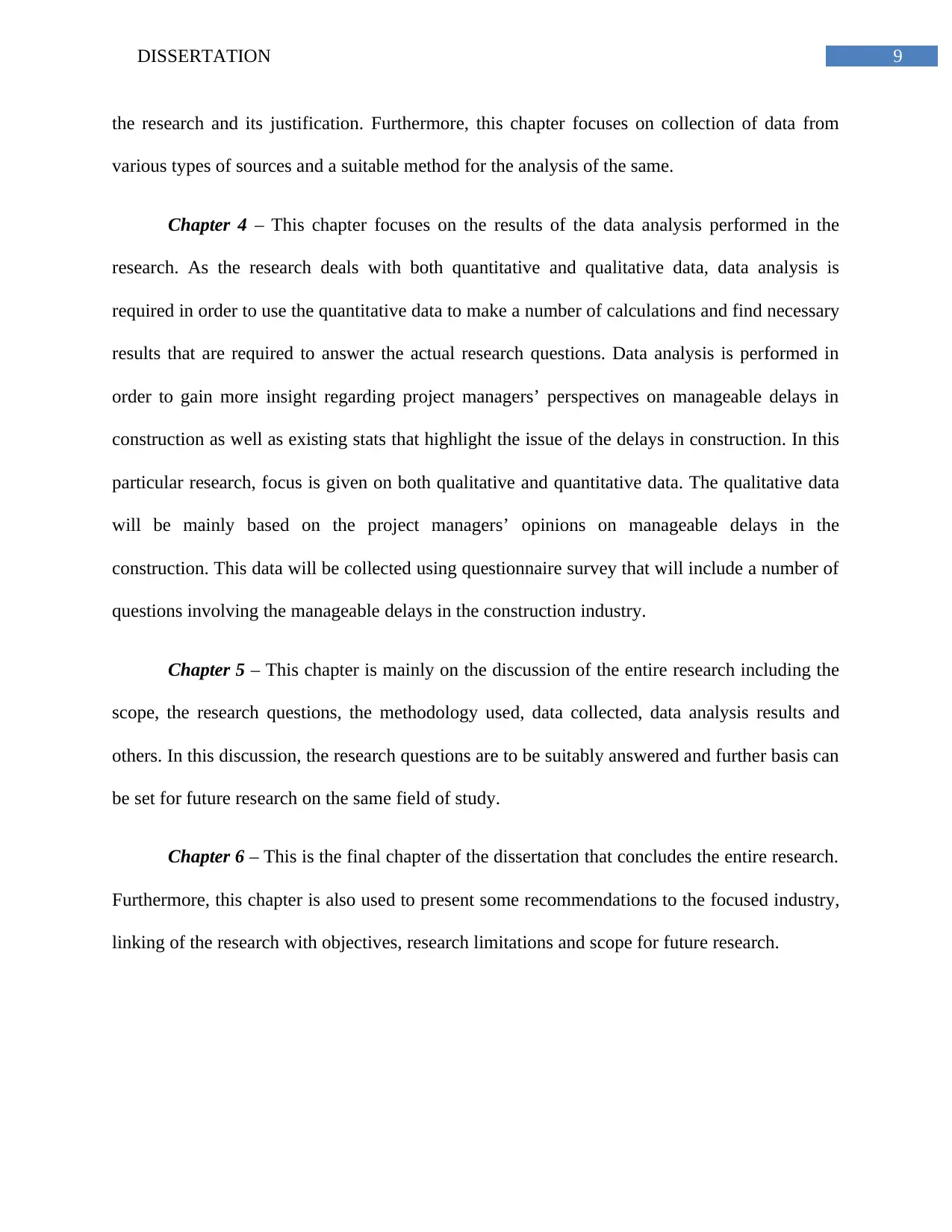
9DISSERTATION
the research and its justification. Furthermore, this chapter focuses on collection of data from
various types of sources and a suitable method for the analysis of the same.
Chapter 4 – This chapter focuses on the results of the data analysis performed in the
research. As the research deals with both quantitative and qualitative data, data analysis is
required in order to use the quantitative data to make a number of calculations and find necessary
results that are required to answer the actual research questions. Data analysis is performed in
order to gain more insight regarding project managers’ perspectives on manageable delays in
construction as well as existing stats that highlight the issue of the delays in construction. In this
particular research, focus is given on both qualitative and quantitative data. The qualitative data
will be mainly based on the project managers’ opinions on manageable delays in the
construction. This data will be collected using questionnaire survey that will include a number of
questions involving the manageable delays in the construction industry.
Chapter 5 – This chapter is mainly on the discussion of the entire research including the
scope, the research questions, the methodology used, data collected, data analysis results and
others. In this discussion, the research questions are to be suitably answered and further basis can
be set for future research on the same field of study.
Chapter 6 – This is the final chapter of the dissertation that concludes the entire research.
Furthermore, this chapter is also used to present some recommendations to the focused industry,
linking of the research with objectives, research limitations and scope for future research.
the research and its justification. Furthermore, this chapter focuses on collection of data from
various types of sources and a suitable method for the analysis of the same.
Chapter 4 – This chapter focuses on the results of the data analysis performed in the
research. As the research deals with both quantitative and qualitative data, data analysis is
required in order to use the quantitative data to make a number of calculations and find necessary
results that are required to answer the actual research questions. Data analysis is performed in
order to gain more insight regarding project managers’ perspectives on manageable delays in
construction as well as existing stats that highlight the issue of the delays in construction. In this
particular research, focus is given on both qualitative and quantitative data. The qualitative data
will be mainly based on the project managers’ opinions on manageable delays in the
construction. This data will be collected using questionnaire survey that will include a number of
questions involving the manageable delays in the construction industry.
Chapter 5 – This chapter is mainly on the discussion of the entire research including the
scope, the research questions, the methodology used, data collected, data analysis results and
others. In this discussion, the research questions are to be suitably answered and further basis can
be set for future research on the same field of study.
Chapter 6 – This is the final chapter of the dissertation that concludes the entire research.
Furthermore, this chapter is also used to present some recommendations to the focused industry,
linking of the research with objectives, research limitations and scope for future research.
Paraphrase This Document
Need a fresh take? Get an instant paraphrase of this document with our AI Paraphraser
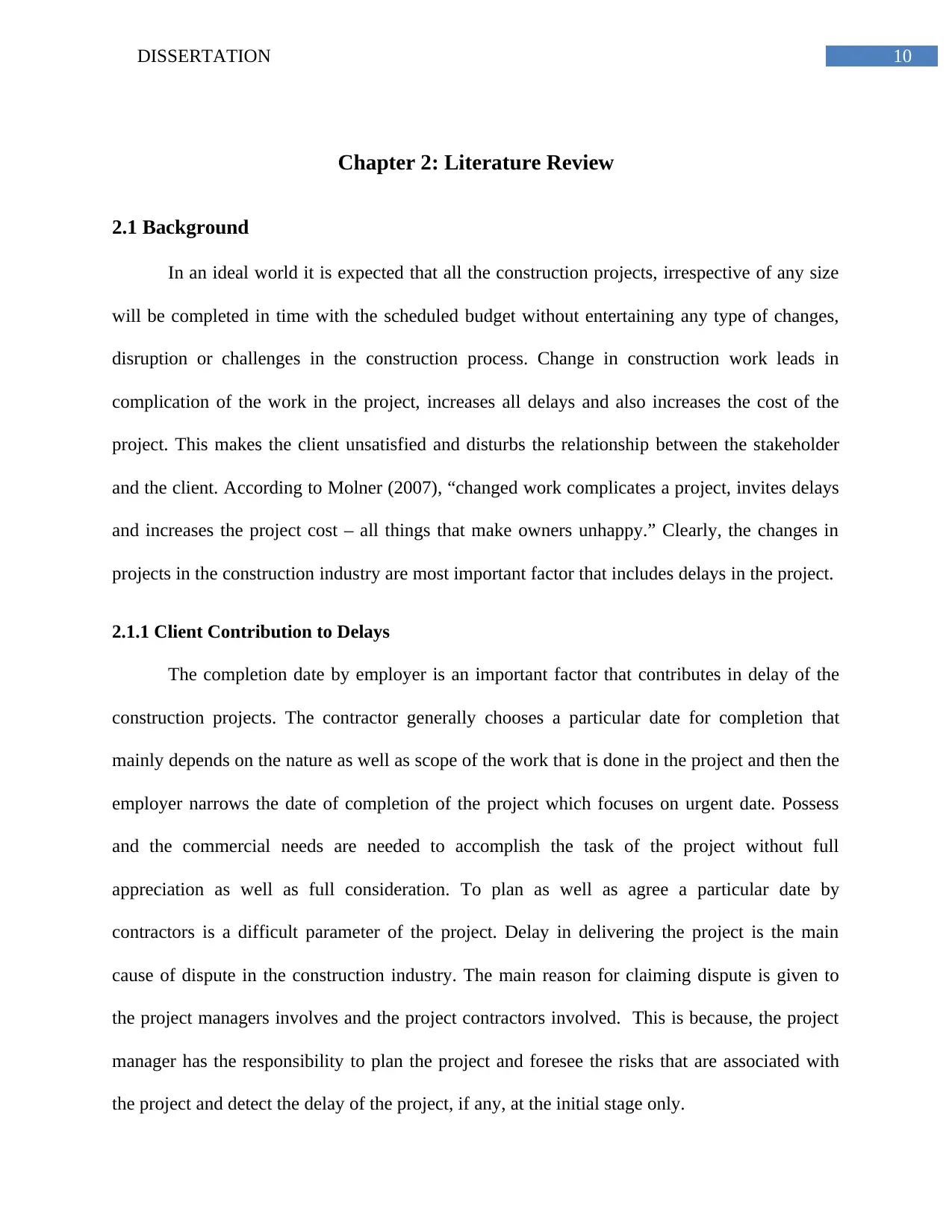
10DISSERTATION
Chapter 2: Literature Review
2.1 Background
In an ideal world it is expected that all the construction projects, irrespective of any size
will be completed in time with the scheduled budget without entertaining any type of changes,
disruption or challenges in the construction process. Change in construction work leads in
complication of the work in the project, increases all delays and also increases the cost of the
project. This makes the client unsatisfied and disturbs the relationship between the stakeholder
and the client. According to Molner (2007), “changed work complicates a project, invites delays
and increases the project cost – all things that make owners unhappy.” Clearly, the changes in
projects in the construction industry are most important factor that includes delays in the project.
2.1.1 Client Contribution to Delays
The completion date by employer is an important factor that contributes in delay of the
construction projects. The contractor generally chooses a particular date for completion that
mainly depends on the nature as well as scope of the work that is done in the project and then the
employer narrows the date of completion of the project which focuses on urgent date. Possess
and the commercial needs are needed to accomplish the task of the project without full
appreciation as well as full consideration. To plan as well as agree a particular date by
contractors is a difficult parameter of the project. Delay in delivering the project is the main
cause of dispute in the construction industry. The main reason for claiming dispute is given to
the project managers involves and the project contractors involved. This is because, the project
manager has the responsibility to plan the project and foresee the risks that are associated with
the project and detect the delay of the project, if any, at the initial stage only.
Chapter 2: Literature Review
2.1 Background
In an ideal world it is expected that all the construction projects, irrespective of any size
will be completed in time with the scheduled budget without entertaining any type of changes,
disruption or challenges in the construction process. Change in construction work leads in
complication of the work in the project, increases all delays and also increases the cost of the
project. This makes the client unsatisfied and disturbs the relationship between the stakeholder
and the client. According to Molner (2007), “changed work complicates a project, invites delays
and increases the project cost – all things that make owners unhappy.” Clearly, the changes in
projects in the construction industry are most important factor that includes delays in the project.
2.1.1 Client Contribution to Delays
The completion date by employer is an important factor that contributes in delay of the
construction projects. The contractor generally chooses a particular date for completion that
mainly depends on the nature as well as scope of the work that is done in the project and then the
employer narrows the date of completion of the project which focuses on urgent date. Possess
and the commercial needs are needed to accomplish the task of the project without full
appreciation as well as full consideration. To plan as well as agree a particular date by
contractors is a difficult parameter of the project. Delay in delivering the project is the main
cause of dispute in the construction industry. The main reason for claiming dispute is given to
the project managers involves and the project contractors involved. This is because, the project
manager has the responsibility to plan the project and foresee the risks that are associated with
the project and detect the delay of the project, if any, at the initial stage only.
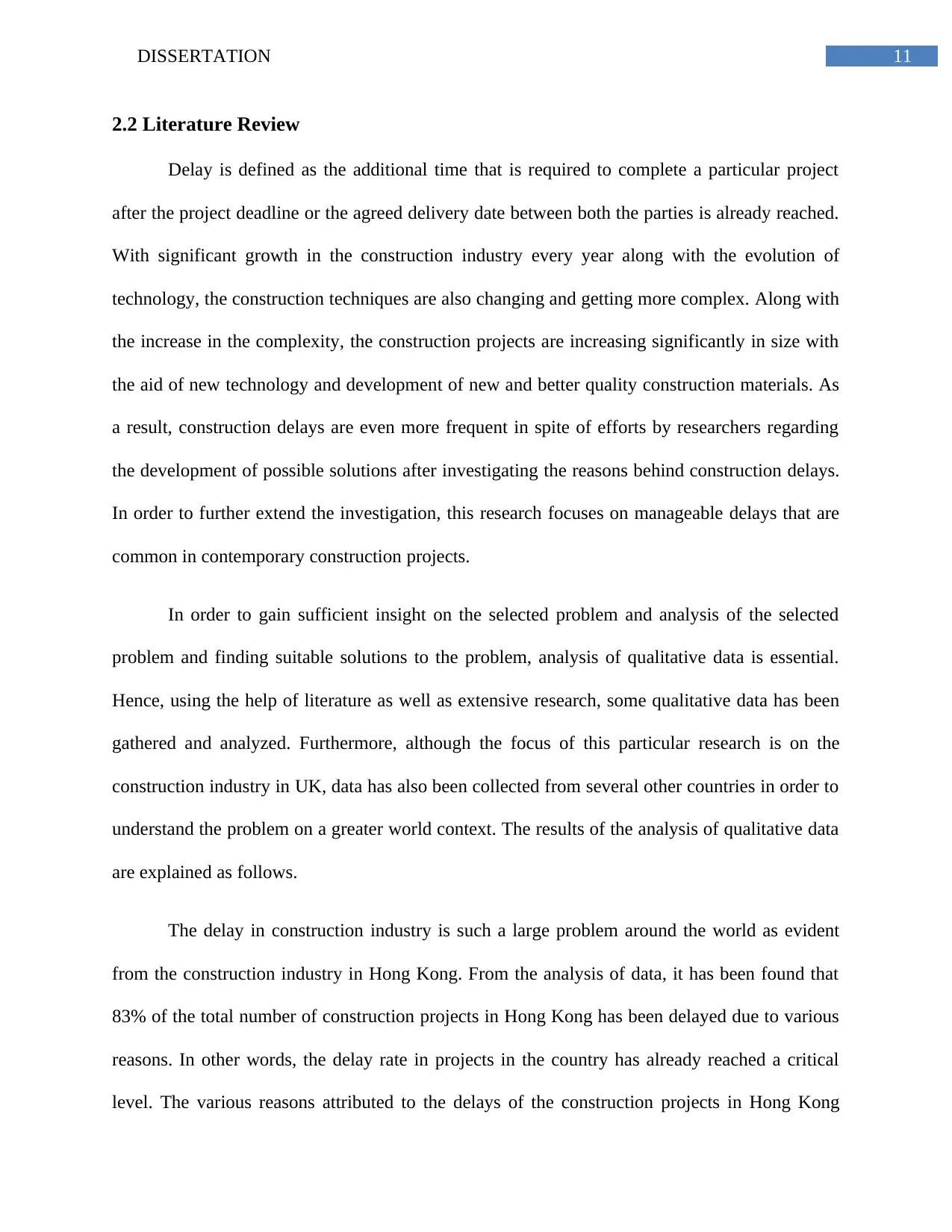
11DISSERTATION
2.2 Literature Review
Delay is defined as the additional time that is required to complete a particular project
after the project deadline or the agreed delivery date between both the parties is already reached.
With significant growth in the construction industry every year along with the evolution of
technology, the construction techniques are also changing and getting more complex. Along with
the increase in the complexity, the construction projects are increasing significantly in size with
the aid of new technology and development of new and better quality construction materials. As
a result, construction delays are even more frequent in spite of efforts by researchers regarding
the development of possible solutions after investigating the reasons behind construction delays.
In order to further extend the investigation, this research focuses on manageable delays that are
common in contemporary construction projects.
In order to gain sufficient insight on the selected problem and analysis of the selected
problem and finding suitable solutions to the problem, analysis of qualitative data is essential.
Hence, using the help of literature as well as extensive research, some qualitative data has been
gathered and analyzed. Furthermore, although the focus of this particular research is on the
construction industry in UK, data has also been collected from several other countries in order to
understand the problem on a greater world context. The results of the analysis of qualitative data
are explained as follows.
The delay in construction industry is such a large problem around the world as evident
from the construction industry in Hong Kong. From the analysis of data, it has been found that
83% of the total number of construction projects in Hong Kong has been delayed due to various
reasons. In other words, the delay rate in projects in the country has already reached a critical
level. The various reasons attributed to the delays of the construction projects in Hong Kong
2.2 Literature Review
Delay is defined as the additional time that is required to complete a particular project
after the project deadline or the agreed delivery date between both the parties is already reached.
With significant growth in the construction industry every year along with the evolution of
technology, the construction techniques are also changing and getting more complex. Along with
the increase in the complexity, the construction projects are increasing significantly in size with
the aid of new technology and development of new and better quality construction materials. As
a result, construction delays are even more frequent in spite of efforts by researchers regarding
the development of possible solutions after investigating the reasons behind construction delays.
In order to further extend the investigation, this research focuses on manageable delays that are
common in contemporary construction projects.
In order to gain sufficient insight on the selected problem and analysis of the selected
problem and finding suitable solutions to the problem, analysis of qualitative data is essential.
Hence, using the help of literature as well as extensive research, some qualitative data has been
gathered and analyzed. Furthermore, although the focus of this particular research is on the
construction industry in UK, data has also been collected from several other countries in order to
understand the problem on a greater world context. The results of the analysis of qualitative data
are explained as follows.
The delay in construction industry is such a large problem around the world as evident
from the construction industry in Hong Kong. From the analysis of data, it has been found that
83% of the total number of construction projects in Hong Kong has been delayed due to various
reasons. In other words, the delay rate in projects in the country has already reached a critical
level. The various reasons attributed to the delays of the construction projects in Hong Kong
⊘ This is a preview!⊘
Do you want full access?
Subscribe today to unlock all pages.

Trusted by 1+ million students worldwide
1 out of 95